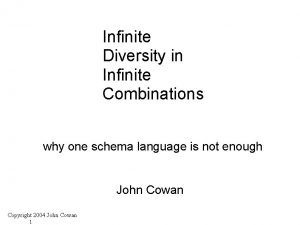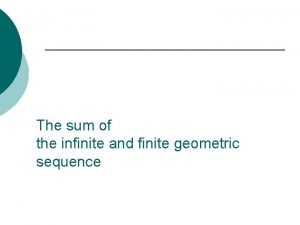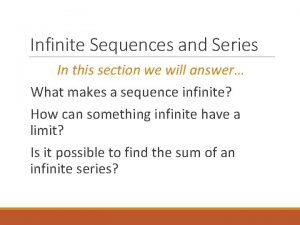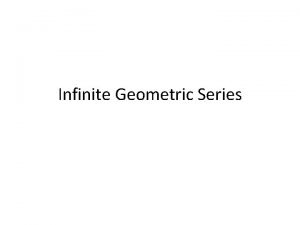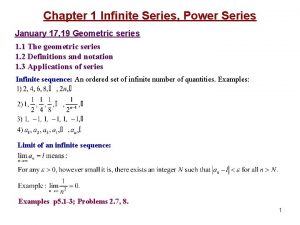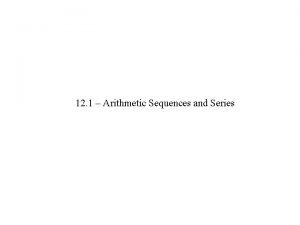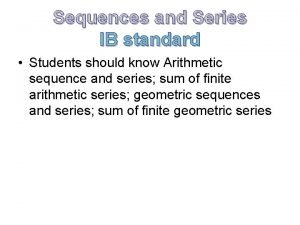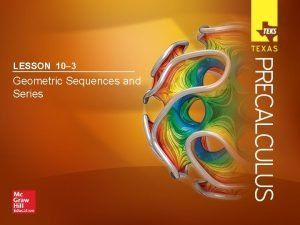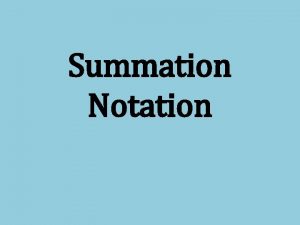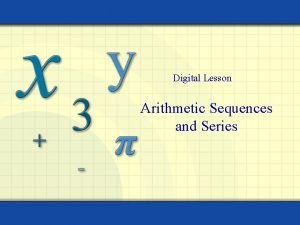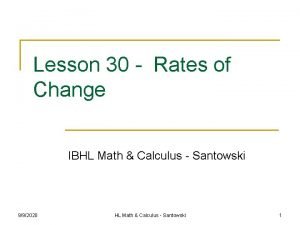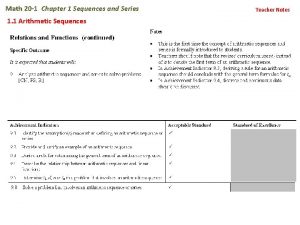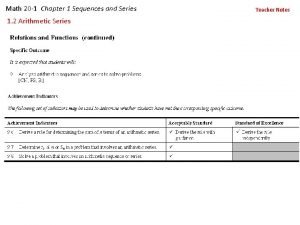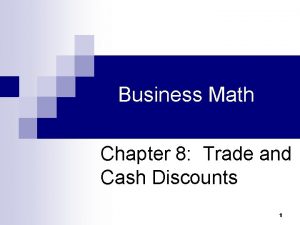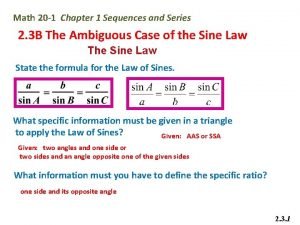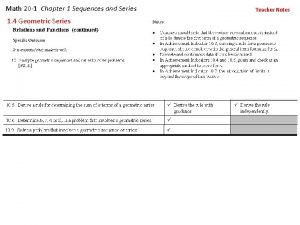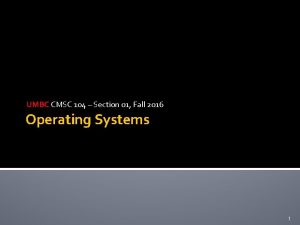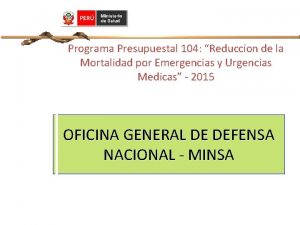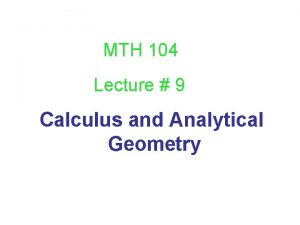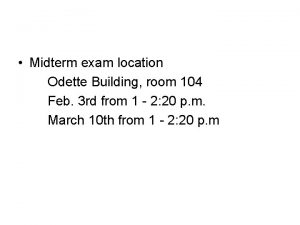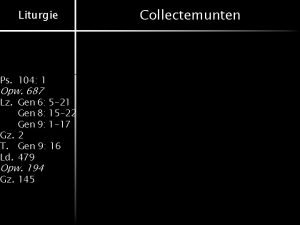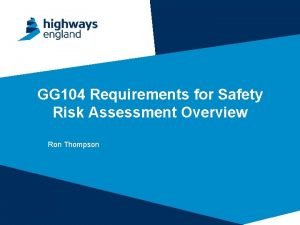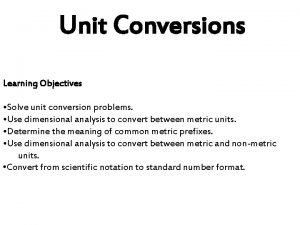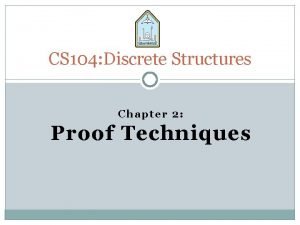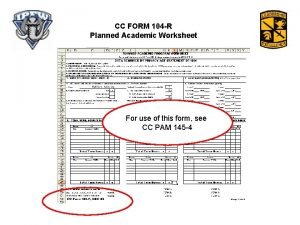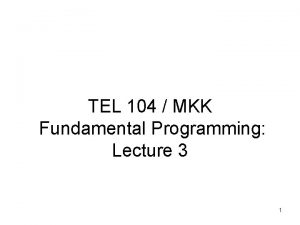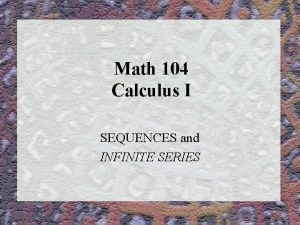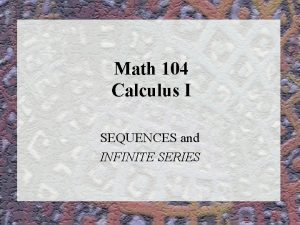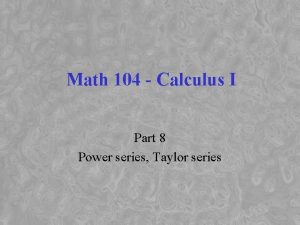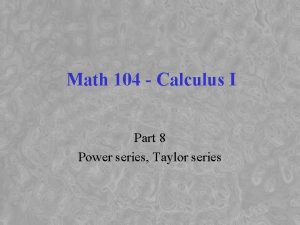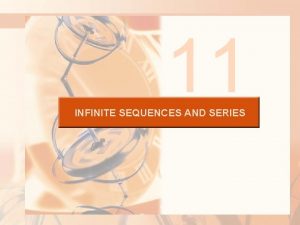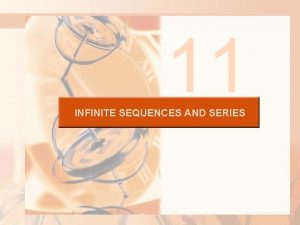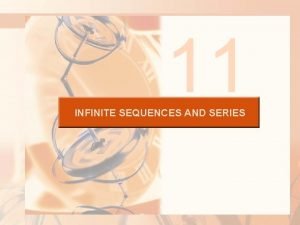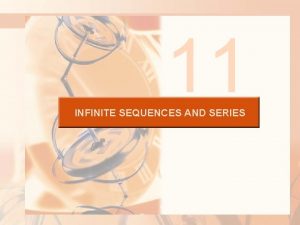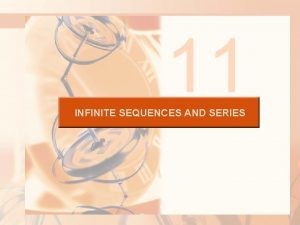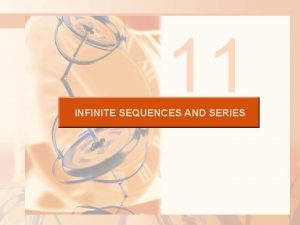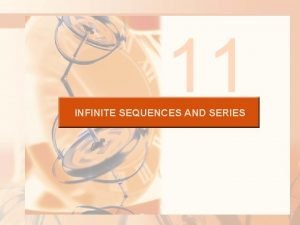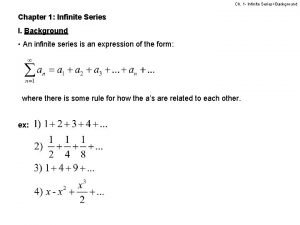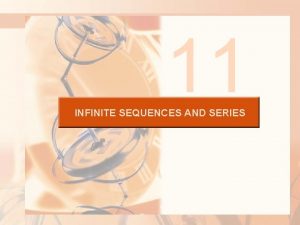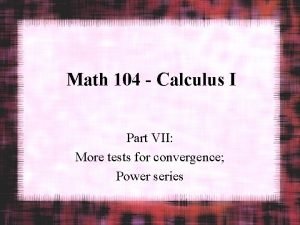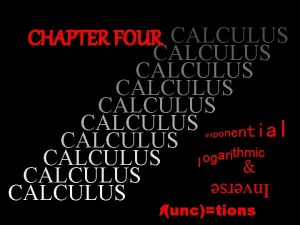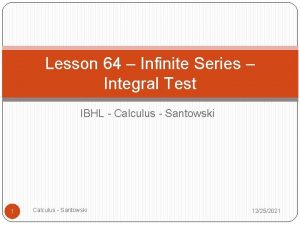Math 104 Calculus I Part 6 INFINITE SERIES


















































- Slides: 50

Math 104 Calculus I Part 6 INFINITE SERIES

Series of Constants We’ve looked at limits and sequences. Now, we look at a specific kind of sequential limit, namely the limit (or sum) of a series.

Zeno’s Paradox How can an infinite number of things happen in a finite amount of time? (Zeno's paradox concerned Achilles and a tortoise)

Discussion Questions 1. Is Meg Ryan’s reasoning correct? If it isn't, what is wrong with it? 2. If the ball bounces an infinite number of times, how come it stops? How do you figure out the total distance traveled by the ball?

Resolution The resolution of these problems is accomplished by the use of limits. In particular, each is resolved by understanding why it is possible to "add together" an infinite number of numbers and get a finite sum.

An example Meg Ryan worried about adding together

Picture This The picture suggests that the "infinite sum" should be 1. This is in fact true, but requires some proof. We'll provide the proof, but in a more general context.

The idea of a series A "series" is any "infinite sum" of numbers. Usually there is some pattern to the numbers, so we can give an idea of the pattern either by giving the first few numbers, or by giving an actual formula for the nth number in the list. For example, we could write The things being added together are called “terms” of the series.

Other series we will consider. . .

Two obvious questions 1. Does the series have a sum? (Officially: "Does the series converge? ") 2. What is the sum? (Officially: "What does the series converge to? ")

A less obvious question is. . . 3. How fast does the series converge?

Convergence The word convergence suggests a limiting process. Fortunately, we don't have to invent a new kind of limit for series. Think of series as a process of adding together the terms starting from the beginning. Then the nth "partial sum" of the series is simply the sum of the first n terms of the series.

For example. . . the partial sums of the IQ series are: 1 st partial sum = 1/2 2 nd partial sum = 1/2 + 1/4 = 3/4 3 rd partial sum = 1/2 + 1/4 + 1/8 = 7/8 and so forth. It looks line the nth partial sum of the IQ series is

It is only natural It is natural to define (and this is even the official definition!) the sum or limit of the series to be equal to the limit of the sequence of its partial sums, if the latter limit exists. For the IQ series, we really do have: This bears out our earlier suspicion.

This presents a problem. . . The problem is that it is often difficult or impossible to get an explicit expression for the partial sums of a series. So, as with integrals, we'll learn a few basic examples, and then do the best we can -sometimes only answering question 1, other times managing 1 and 2, and still other times 1, 2, and 3.

Geometric series The IQ series is a specific example of a geometric series. A geometric series has terms that are (possibly a constant times) the successive powers of a number. The IQ series has successive powers of 1/2.

Other examples

Convergence of geometric series Start (how else? ) with partial sums Finite geometric sum: Therefore and so

We conclude that. . .

connect Some questions Which of the geometric series on the previous slide (reproduced on the next slide) converge? What do they converge to?

Other examples

Telescoping series Another kind of series that we can sum: telescoping series This seems silly at first, but it's not! A series is said to telescope if all the terms in the partial sums cancel except perhaps for the first and the last.

Example

What’s the big deal? Well, you could rewrite the series as which is not so obvious (in fact, it was one of the examples given near the beginning of today’s class).

Now you try one. . . A) B) C) D) E) 1 3/4 1/2 1/4 1/8

Improper integrals Occasionally it helps to recognize a series as a telescoping series. One important example of such a series is provided by improper integrals. Suppose F '(x) = f(x). Then we can think of the improper integral as being the sum of the series

Continued. . . Since the nth partial sum of this series is F(n+1) F(1), it's clear that the series converges to just as the integral would be equal to (Note the subtle difference between the two limits -- the limit of the series might exist even when the improper integral does not).

The convergence question For a while, we’ll concentrate on the question 1: Does the series converge? One obvious property that convergent series must have is that their terms must get smaller and smaller in order for the limit of the partial sums to exist.

Fundamental necessary condition for convergence: This is only a test you can use to prove that a series does NOT converge

Harmonic Just because the nth term goes to zero doesn't mean that the series converges. An important example is the harmonic series We can show that the harmonic series diverges by the following argument using the partial sums: For the harmonic series,

Harmonic (cont. ) and so on -- every time we double the number of terms, we add at least one more half. This indicates (and by induction we could prove) that

Cantilever tower: The divergence of the harmonic series makes the following trick possible. It is possible to stack books (or cards, or any other kind of stackable, identical objects) near the edge of a table so that the top object is completely off the table (and as far off as one wishes, provided you have enough objects to stack).

Series of positive terms Convergence questions for series of positive terms are easiest to understand conceptually. Since all the terms an are assumed to be positive, the sequence of partial sums {S n} must be an increasing sequence. So the least upper bound property discussed earlier comes into play -- either the sequence of partial sums has an upper bound or it doesn't. If the sequence of partial sums is bounded above, then it must converge and so will the series. If not, then the series diverges. That's it.

Tests for convergence of series of positive terms: The upper bound observations give rise to several "tests" for convergence of series of positive terms. They all are based pretty much on common sense ways to show that the partial sums of the series being tested is bounded are all less than those of a series that is known to converge (or greater than those of a series that is known to diverge). The names of the tests we will discuss are. . .

Tests. . . TODAY 1. The integral test TODAY 2. The comparison test 3. The ratio test 4. The limit comparison test (sometimes called the ratio comparison test) 5. The root test

The integral test Since improper integrals of the form provide us with many examples of telescoping series whose convergence is readily determined, we can use integrals to determine convergence of series:

For example, consider the series From the following picture, it is evident that the nth partial sum of this series is less than Integral test cont.

The sum of the terms is equal to the sum of the areas What is the of the shaded rectangles, and sum? if we start integrating at 1 instead of 0, the improper integral converges (question: what is the integral? so what bound to you conclude for the series? ). Since the value of the improper integral (plus 1) provides us with an upper bound for all of the partial sums, the series must converge. It is an interesting question as to exactly what the sum is. We will answer it next week.

The integral test. . .

Discussion and Connect Question… -- for which exponents p does the series converge? (These are sometimes called p-series, for obvious reasons -- these together with the geometric series give us lots of useful examples of series whose convergence or divergence we know).

Error estimates: Using the picture that proves the integral test for convergent series, we can get an estimate on how far off we are from the limit of the series if we stop adding after N terms for any finite value of N. If we approximate the convergent series by the partial sum then the error we commit is less than the value of the integral

Take a closer look. . .

Question A) Converge B) Diverge

Question A) Converge B) Diverge

Exercise Connect For this latter series, find a bound on the error if we use the sum of the first 100 terms to approximate the limit. (answer: it is less than about. 015657444)

The comparison test This convergence test is even more commonsensical than the integral test. It says that if all the terms of the series are less than the corresponding terms of the series and if converges, then converges also.

Reverse This test can also be used in reversed -- if the b series diverges and the a’s are bigger than the corresponding b’s, then diverges also.

Examples:

Question A) Converge B) Diverge

Question A) Converge B) Diverge
 Infinite diversity in infinite combinations
Infinite diversity in infinite combinations Finite geometric sequence
Finite geometric sequence Formula for sum of harmonic series
Formula for sum of harmonic series Formula for infinite geometric series
Formula for infinite geometric series Formula for infinite geometric series
Formula for infinite geometric series L'hopital's rule
L'hopital's rule Ramanujan infinite series
Ramanujan infinite series Arithmetic sequences and series
Arithmetic sequences and series Arithmetic series formula
Arithmetic series formula Sum of geometric series
Sum of geometric series 1/4^n convergence
1/4^n convergence Difference between finite and infinite sequence
Difference between finite and infinite sequence Sum of infinite ap
Sum of infinite ap Sequences and series formulae
Sequences and series formulae Recursive formula for geometric sequence
Recursive formula for geometric sequence Summation notation
Summation notation Partial sum of arithmetic sequence
Partial sum of arithmetic sequence Flipped math calculus
Flipped math calculus 30rates
30rates Maclaurin series vs taylor series
Maclaurin series vs taylor series Balmer series lyman series
Balmer series lyman series Taylor series of composite functions
Taylor series of composite functions Taylor vs maclaurin
Taylor vs maclaurin Ibm p series servers
Ibm p series servers General feedback structure
General feedback structure Series aiding and series opposing
Series aiding and series opposing Chapter 1 sequences and series
Chapter 1 sequences and series Sequences and series math 20-1
Sequences and series math 20-1 Formula of net price
Formula of net price Sequences and series math 20-1
Sequences and series math 20-1 Chapter 1 sequences and series
Chapter 1 sequences and series Apple notes
Apple notes Programa presupuestal 104
Programa presupuestal 104 Lativ104
Lativ104 Mth 104
Mth 104 Odette building 104
Odette building 104 Fyodor urnov
Fyodor urnov Psalm 104
Psalm 104 Gg-104
Gg-104 Cct 104
Cct 104 Aphorism 83 to 104
Aphorism 83 to 104 Cao 104
Cao 104 Cao design
Cao design Kilimanjaro song lyrics jambo bwana
Kilimanjaro song lyrics jambo bwana Csci 104
Csci 104 Michael tells sara he weighs 104 pounds
Michael tells sara he weighs 104 pounds I 102 104
I 102 104 Ignite your business
Ignite your business Cs 104
Cs 104 104-r planned academic worksheet
104-r planned academic worksheet Tel 104
Tel 104
